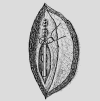History of Bone Grafts in Spine Surgery
- PMID: 35663670
- PMCID: PMC9156791
- DOI: 10.7759/cureus.24655
History of Bone Grafts in Spine Surgery
Abstract
Bone grafting replaces damaged or missing bone with new bone and is used for surgical arthrodesis. Patients benefit from a huge variety of bone graft techniques and options for spinal fusions. This article reviews the rich history of bone grafts in surgery with particular emphasis on spinal fusion. During the early years of bone grafting in spine surgery, bone grafts were used on tuberculosis patients, and the structural support of the graft was most the important consideration. Between 1960 and 2000, many advances were made, specifically in the use of bone graft substitutes. The field of bone grafts in spine surgery has evolved rapidly since first described.
Keywords: bone graft; bone graft substitutes; history; spinal fusion; spine; surgery.
Copyright © 2022, Hampel et al.
Conflict of interest statement
The authors have declared that no competing interests exist.
Figures





Similar articles
-
Bone graft substitutes for spine fusion: A brief review.World J Orthop. 2015 Jul 18;6(6):449-56. doi: 10.5312/wjo.v6.i6.449. eCollection 2015 Jul 18. World J Orthop. 2015. PMID: 26191491 Free PMC article. Review.
-
Bone grafting for spinal fusion.Orthop Clin North Am. 1999 Oct;30(4):685-98. doi: 10.1016/s0030-5898(05)70120-6. Orthop Clin North Am. 1999. PMID: 10471772 Review.
-
Anterior debridement, bone grafting and fixation for cervical spine tuberculosis: an iliac bone graft versus a structural manubrium graft.BMC Musculoskelet Disord. 2022 Mar 11;23(1):236. doi: 10.1186/s12891-022-05177-0. BMC Musculoskelet Disord. 2022. PMID: 35277155 Free PMC article.
-
A post-market surveillance analysis of the safety of hydroxyapatite-derived products as bone graft extenders or substitutes for spine fusion.Eur Rev Med Pharmacol Sci. 2015 Oct;19(19):3548-55. Eur Rev Med Pharmacol Sci. 2015. PMID: 26502842
-
Comparison of Healos/bone marrow to INFUSE(rhBMP-2/ACS) with a collagen-ceramic sponge bulking agent as graft substitutes for lumbar spine fusion.Spine (Phila Pa 1976). 2005 May 1;30(9):1001-7; discussion 1007. doi: 10.1097/01.brs.0000160997.91502.3b. Spine (Phila Pa 1976). 2005. PMID: 15864149
Cited by
-
Photobiomodulation Therapy Improves Repair of Bone Defects Filled by Inorganic Bone Matrix and Fibrin Heterologous Biopolymer.Bioengineering (Basel). 2024 Jan 13;11(1):78. doi: 10.3390/bioengineering11010078. Bioengineering (Basel). 2024. PMID: 38247955 Free PMC article.
-
Combination of a Synthetic Bioceramic Associated with a Polydioxanone-Based Membrane as an Alternative to Autogenous Bone Grafting.Biomimetics (Basel). 2024 May 10;9(5):284. doi: 10.3390/biomimetics9050284. Biomimetics (Basel). 2024. PMID: 38786494 Free PMC article.
-
Bone Regeneration: Mini-Review and Appealing Perspectives.Bioengineering (Basel). 2025 Jan 7;12(1):38. doi: 10.3390/bioengineering12010038. Bioengineering (Basel). 2025. PMID: 39851312 Free PMC article. Review.
-
High Strength and Shape Memory Spinal Fusion Device for Minimally Invasive Interbody Fusions.Int J Nanomedicine. 2024 Jun 1;19:5109-5123. doi: 10.2147/IJN.S460339. eCollection 2024. Int J Nanomedicine. 2024. PMID: 38846643 Free PMC article.
-
Comparative Evaluation of Mineralized Bone Allografts for Spinal Fusion Surgery.J Funct Biomater. 2023 Jul 21;14(7):384. doi: 10.3390/jfb14070384. J Funct Biomater. 2023. PMID: 37504879 Free PMC article.
References
-
- Urist MR, O’Connor BT, Burwell RG. Vol. 1994. Cambridge: Butterworth-Heinemann; 1994. Bone Graft, Derivatives & Substitutes; pp. 3–102.
-
- Chirurgianellapreistoria. Parte I. Flati G, Di Stanislao C. Provincia Med Aquila. 2004;2:8–11.
-
- Hibbs osteoplastic operation for Pott's disease. Report of clinical observations with results in one hundred and fifty-eight cases, and interpretation of experimental studies in animals. Farrell B. JAMA. 1915;LXIV:398–400.
-
- The fundamental principles involved in the use of the bone graft in surgery. Albee F. Am J Med Sci. 1915;149:313–325.
-
- Il primo trapianto omoplastico di un arto secondo la leggenda dei santi Cosma e Damiano. Rinaldi E. G Ital Ortop Traumatol. 1987;13:405–417.
Publication types
LinkOut - more resources
Full Text Sources
